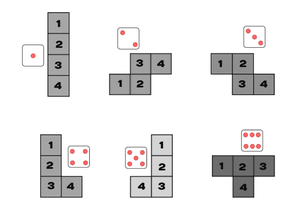Moon Drop
- Early draft of a replayable roll-and-write dice game based on The Twenty-Fifth Dynasty of Kevan, as discussed on the Slack channel.
Contents
You will need
- Four white dice and one blue (or any five dice; you'll just have to roll them in turn)
- A 9x9 grid on a sheet of paper, for each player
- A pen for each player
Gameplay
The game is played over seven rounds. Start each round by generating a block:
- One player rolls all five dice
- The blue die determins the block shape (per diagram to the right)
- The white dice should then be shaped to form that block, placing the lowest white die on the 1 square, the next lowest on the 2, and so on
Each player then copies that block onto their grid, in any location and rotation they wish. It can't overwrite existing blocks, and blocks can only be rotated, not mirrored. The white dice values correspond to six types of module:-
- Corridor. (Initially drawn as a line from the centre of a square to the block it's joined onto. Players should extend corridors into corners and junctions and crossroads as the game progresses; this is just a visual shorthand, they're all just corridors.)
- Corridor.
- Life Support (drawn as a triangle) or Hydroponics (drawn as three circles in a triangle)
- Quarters (drawn as a Q)
- Dock (drawn as an arch)
- Research (drawn as a square)
Continue placing until seven rounds have been played, then proceed to scoring.
Scoring system #1
A building is a group of contiguous modules that do not have any other modules contiguous with them. (Adjacency is always orthogonal.)
Crewmembers can "reach" a module if you can trace a path from a Quarters to it. This path can be along corridors, and crew can also move between Docks if there is a clear route of empty squares between those Docks. (This needs sharper wording.)
A Safety Check is the following set of actions:-
- Check Routes: Cross out any modules which your crewmembers cannot reach (crossed out modules become a "null" module which exists but doesn't do anything)
- Life Support: If a building has no Life Support, cross out all Quarters in that building
- Check Routes again
- Hydroponics: If a building has more Quarters than Hydroponics, cross out Quarters until it has as many as Hydroponics
- Check Routes again
Crises and Goals
Trying something new for the final scoring. At the start of the game, deal out three Crisis cards face-up from a deck and one Goal card from another deck. Each Crisis has a "Safe" criteria, and an "If failed" effect that you must apply if you fail it.
- Crisis: Fire: Safe if: Every building has 1 Life Support. If failed: Cross out 1 Quarters and 1 non-Quarters Module per building.
- Crisis: Breach: Safe if: No corridors are adjacent to empty square. If failed: Cross out 1 Quarters for each such corridor.
- Crisis: Plague: Safe if: You have no Quarters adjacent to other Quarters. If failed: Cross out all Quarters which are adjacent to other Quarters.
- Crisis: Quake: Safe if: Every non-corridor Module is adjacent to at least two others. If failed: Cross out each module which isn't.
- Crisis: Fungus: Safe if: Every Hydroponics is connected to a Life Support. If failed: Cross out each Hydroponics which isn't.
- Crisis: Sabotage: Safe if: Every Dock is adjacent to a Quarters. If failed: Select your largest group of non-Corridor, non-Quarters Modules and cross it all out.
- Goal: Research: +1 for each Research Module which has not been crossed out.
- Goal: Mining: +1 for each empty square which has no path to the edge of the grid.
- Goal: Efficiency: +1 for every square in your largest corridor.
- Goal: Population: +1 for every Quarters which has not been crossed out.
- Goal: Security: +4 for each inhabited Building beyond the first
At the end of the game, everyone performs a Safety Check. Then shuffle the three Crisis cards and resolve them in a random order, performing a Safety Check after each one. Then score the Goal card.
Variations to test
- Allow blocks to be mirrored: this requires only five faces on the blue die (and could bring back the 2x2 block), so the sixth face could be some kind of free placement.
- Allow players to overwrite blocks, but destroying that square in the process (scribbling it out).
- Have corridors function based on how they're drawn: you can choose not to join a corridor to an adjacent block.
